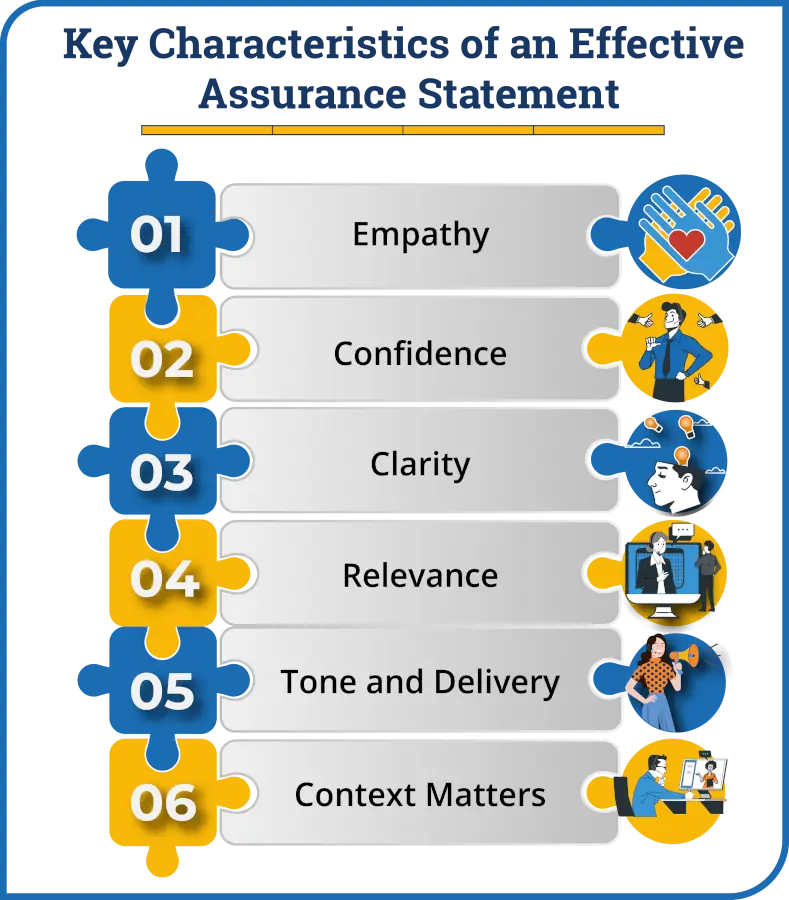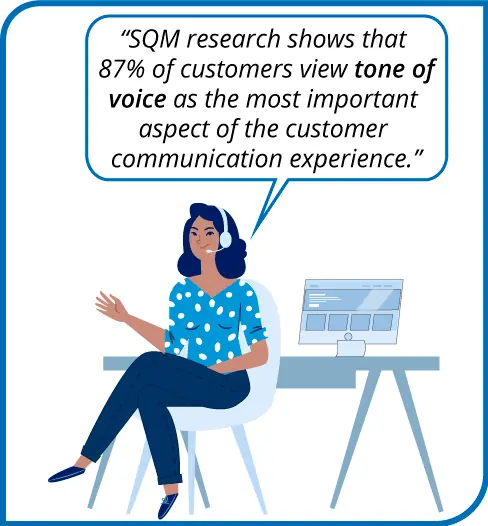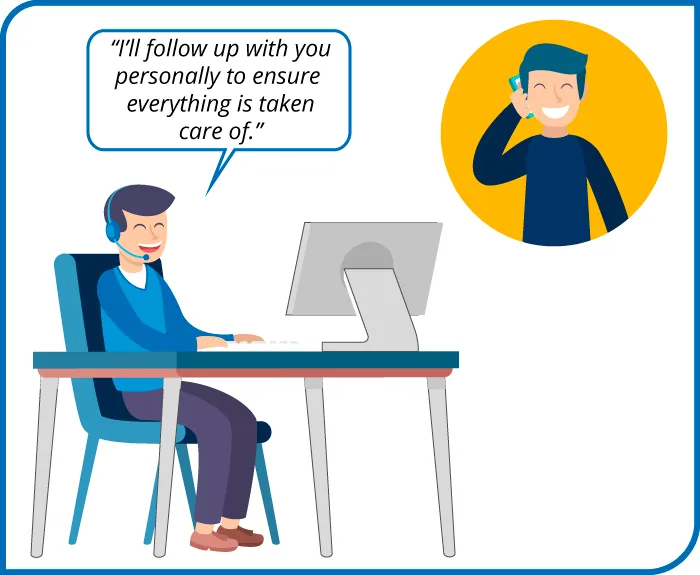Call center agents often face a delicate balance: solving problems quickly while ensuring customers feel heard, understood, and valued. One of the most powerful tools in an agent's toolkit is the ability to reassure customers. Whether it's addressing a billing issue or handling an unexpected delay, reassurance is key to building trust, diffusing tension, and improving customer satisfaction.
Customers who feel anxious, frustrated, or uncertain about a problem need more than just a solution—they need to know that they are in capable hands. The right assurance statement, delivered at the right moment, can not only calm a distressed customer but also turn a potentially negative experience into a positive one.
In fact, reassurance can be a game-changer for customer retention, as studies have shown that a positive customer service experience leads to greater loyalty and long-term satisfaction. SQM Group's customer service research shows that building customer rapport is the second biggest driver for achieving high call center CSat. Only an agent resolving a call is a more significant driver for providing high CSat.
This blog aims to equip agents with the best assurance statements to help them navigate challenging conversations with confidence. Whether you're a seasoned agent or just starting out, you'll find actionable examples that can be used in a variety of customer service scenarios.
By mastering these key reassurance techniques, you can elevate your customer interactions, enhance your team's performance, and contribute to an overall more positive customer experience.
What is an Assurance Statement?
In customer service, assurance statements play a crucial role in calming customers and building their confidence. They reassure customers that the agent they are speaking with is capable and committed to resolving their issue, creating a sense of trust throughout the conversation.
What Makes an Assurance Statement Effective?
In customer service, an assurance statement is more than just a comforting phrase—it's a powerful tool that can influence the outcome of an interaction. But what makes an assurance statement truly effective? To be impactful, an assurance statement must meet several key criteria that will resonate with the customer and make them feel confident in the support they're receiving.
Key Characteristics of an Effective Assurance Statement

1. Empathy
At the heart of every great assurance statement is empathy. Customers don’t just want their issues resolved; they want to feel understood. When you acknowledge the frustration or inconvenience they may be experiencing, you build rapport and demonstrate that you are not just solving a problem, but also caring for the person behind the problem.
Example: "I can completely understand how this might be frustrating for you."

2. Confidence
Customers reach out for help because they need a solution. A confident assurance statement conveys that you are fully equipped to handle their issue, which instills a sense of security. By showing you know what you're doing, you provide customers with a sense of control, even when their own situation feels chaotic.
Example: "Don’t worry, I’ve dealt with similar situations before, and we’ll get this resolved together."

3. Clarity
While empathy and confidence are vital, clarity is just as important. An assurance statement that’s vague or confusing can leave the customer uncertain about what will happen next. Clear communication fosters trust and allows the customer to know exactly what steps are being taken to resolve their issue.
Example: "I’m going to initiate a full review of your account and make sure the error is corrected."

4. Relevance
Assurance should always be tailored to the specific situation at hand. Generic statements might sound polite, but they lack the personal touch that shows the customer you are genuinely engaged with their individual concern. Understanding the customer’s unique needs and responding appropriately creates a deeper connection and strengthens your credibility.
Example: "I know how important it is to get this sorted before your upcoming trip, so I’ll expedite the process."

5. Tone and Delivery
While the words you use are important, how you say them is just as critical. A warm, friendly tone can transform a standard assurance statement into a comforting reassurance. On the other hand, a flat or robotic delivery can make even the most carefully crafted sentence feel insincere. SQM research shows that 87% of customers view tone of voice as the most important aspect of the customer communication experience.

For example, when reassuring a frustrated customer, your tone should convey empathy and understanding, not just recite a script. Slow, deliberate speech also conveys confidence, while rushing through your response can give the impression that you are overwhelmed or not fully invested in the conversation.

6. Context Matters
Effective assurance isn't just about having the right words; it’s also about knowing when to use them. Certain situations demand a more urgent, proactive approach, while others may require a calm and patient tone.
For example, when a customer is calling about a late delivery, an assurance statement that emphasizes urgency and a commitment to resolution will likely be more effective than one that is overly general. On the other hand, when dealing with a complex issue or system malfunction, a more thoughtful, steady reassurance can help the customer feel their problem is in good hands.
10 Best Assurance Statements to Reassure Your Customers
Now that we’ve covered what makes an assurance statement effective, let's explore the 10 best assurance statements call center professionals can use to reassure customers. Each of these statements is designed to address specific customer concerns, build trust, and foster a positive relationship, even in challenging situations.

1. "I completely understand how frustrating this must be for you."
- When to Use It: When the customer is upset, anxious, or expressing frustration about an issue they’ve encountered.
- Why It Works: This statement acknowledges the customer's feelings and shows empathy. It helps to de-escalate the situation by signaling that the agent is not dismissing the customer's experience.
2. "You’re in good hands, I’ll make sure we get this resolved."
- When to Use It: When the customer expresses doubt about whether the issue will be resolved or when they seem unsure of the agent's capabilities.
- Why It Works: It instills confidence in the customer. They feel assured that the agent is both capable and committed to resolving the problem.
3. "Let me take care of that for you right away."
- When to Use It: When the customer has a clear request or need that can be resolved immediately.
- Why It Works: It conveys a sense of urgency and shows the customer that their issue is a priority. It also suggests that the agent is proactive and capable.
4. "I’ll follow up with you personally to ensure everything is taken care of."
- When to Use It: When the issue requires time to resolve or if the agent needs to escalate the issue to another team member.
- Why It Works: This reassures the customer that the agent is taking ownership of the problem and will ensure the matter is resolved, even if it requires more steps.
5. "I’ll make sure to keep you updated every step of the way."
- When to Use It: When the customer’s issue is ongoing or may take time to resolve, especially when they’re likely to be anxious about the progress.
- Why It Works: It emphasizes transparency and keeps the customer informed, preventing frustration from lack of communication. It also reassures them that their issue is being actively handled.
6. "Let’s work together to get this sorted out quickly."
- When to Use It: When troubleshooting a technical problem or when the customer’s issue requires their involvement or input.
- Why It Works: This statement encourages collaboration and partnership, which makes the customer feel more in control and engaged in the solution.
7. "I’m confident we’ll get this resolved for you today."
- When to Use It: When the customer is anxious about how long it will take to resolve their issue.
- Why It Works: This conveys certainty and reassurance, which can help calm a customer who is uncertain about the timeline.
8. "I’m escalating this to ensure it’s handled with priority."
- When to Use It: When the issue is urgent or requires escalation to a higher level of support.
- Why It Works: It reassures the customer that their issue is being taken seriously and will be addressed with urgency. This can help prevent the customer from feeling ignored or unimportant.
9. "We’ve handled similar situations before, and I’m confident we can solve this for you."
- When to Use It: When the customer expresses doubt about the likelihood of a resolution or if they seem unsure that their problem can be solved.
- Why It Works: Drawing on past experience gives the customer confidence that the agent is not only capable but has successfully handled similar issues before.
10. "Thank you for your patience, I’m doing everything I can to get this resolved."
- When to Use It: When the customer has been waiting for a resolution or update, and their patience is wearing thin.
- Why It Works: It shows appreciation for the customer’s patience, which can help maintain a positive relationship, and reassures them that their issue is still a priority.
